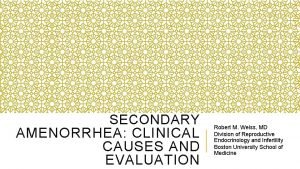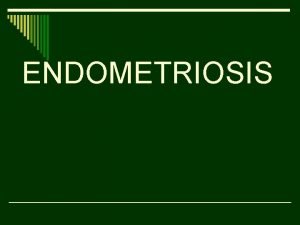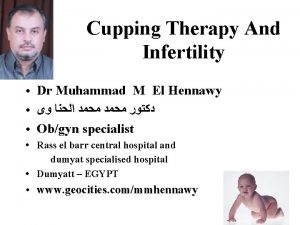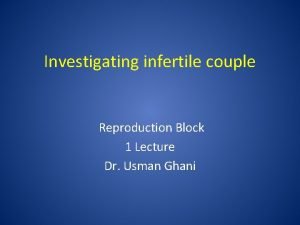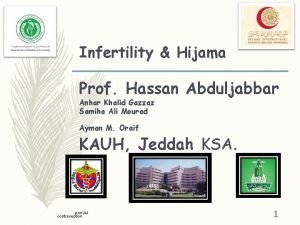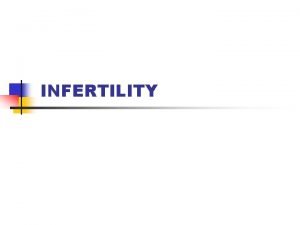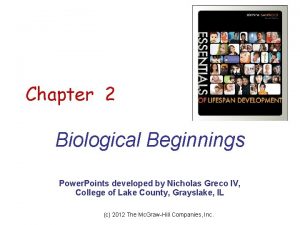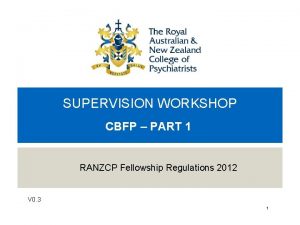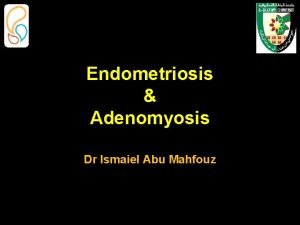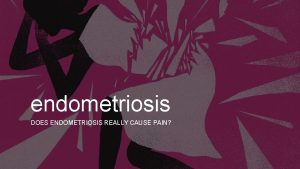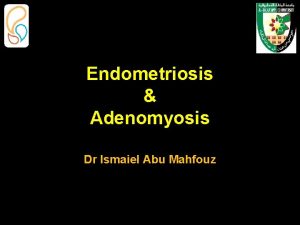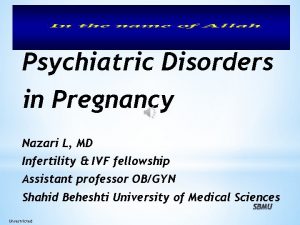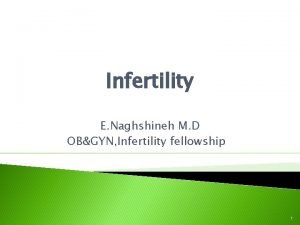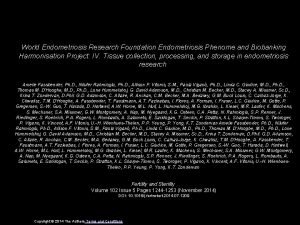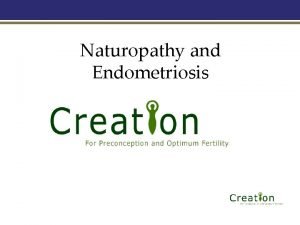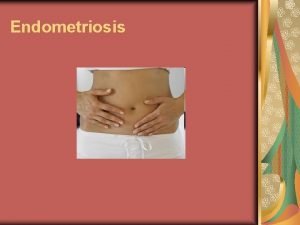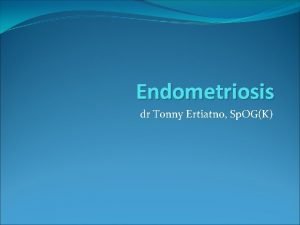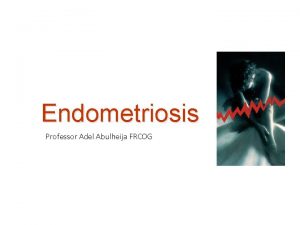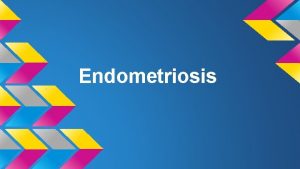Endometriosis Infertility Nazari L MD Infertility fellowship Assistant















- Slides: 15

Endometriosis & Infertility Nazari L, MD Infertility fellowship Assistant professor, SBMU

• Endometriosis is a debilitating condition characterized by high recurrence rates • Typically, endometriosis causes pain and infertility, although 20– 25% of patients are asymptomatic

• Endometriosis and infertility • In normal couples, fecundity is in the range of 0. 15 to 0. 20 per month and decreases with age • Women with endometriosis tend to have a lower monthly fecundity of about 0. 02– 0. 1 per month • In addition, endometriosis is associated with a lower live birth rate • Infertile women are 6 to 8 times more likely to have endometriosis than fertile women

• Mechanisms: üDistorted pelvic anatomy üEndocrine and ovulatory abnormalities üAltered peritoneal function üAltered hormonal and cell-mediated functions in the endometrium

• Major pelvic adhesions or peritubal adhesions that disturb the tuboovarian liaison and tube patency can impair oocyte release from the ovary, inhibit ovum pickup, or impede ovum transport • Women with endometriosis may have endocrine and ovulatory disorders, including luteinized unruptured follicle syndrome, impaired folliculogenesis, luteal phase defect, and premature or multiple luteinizing hormone (LH) surges

• A complex network of humoral and cellular immunity factors modulates the growth and inflammatory behavior of ectopic endometrial implants and affects embryo implantation • Women with endometriosis have an increased volume of peritoneal fluid with a high concentration of activated macrophages, prostaglandins, IL-1, TNF, and proteases • These alterations may have adverse effects on the function of the oocyte, sperm, embryo, or fallopian tube • Ovum capture inhibitor (OCI) in endometriosis peritoneal fluid is thought to be responsible for fimberial failure of ovum capture • Elevated levels of Ig. G and Ig. A antibodies (autoantibodies to endometrial antigens) and lymphocytes may be found in the endometrium of women with endometriosis • These abnormalities may alter endometrial receptivity and embryo implantation

• Treatments for endometriosis and infertility • Endometriosis should be viewed as a chronic disease characterized by pelvic pain and associated with infertility • Requires a life-long personalized management plan with the goal of maximizing medical treatment and avoiding repeated surgical procedures • Treatment for endometriosis is essentially chosen by each individual woman, depending on symptoms, age, and fertility

• For many women, adequate treatment requires a combination of treatments given over their lifetime. The current treatments include medical, surgical, or a combination of these approaches • A combination of surgical treatment and either preoperative or postoperative medical therapy has been suggested for endometriosis

• Surgical treatment followed by medical treatment may prolong the pain-free (or reduced-pain) interval compared to surgery alone • Endometriosis-associated pain has been well studied, and all the established medical therapies provided a better outcome than placebo

• Clinical management of an infertile couple: üAge of the female üDuration of infertility üMale factor üDuration of medical attention üPelvic pain üStage of endometriosis

• Management of infertility associated with endometriosis, clinical decisions are difficult because few RCT have been conducted to evaluate and compare the effectiveness of the various forms of treatment • Effective, evidence-based treatments of endometriosis-associated infertility include conservative surgical therapy and assisted reproductive technologies • Patients with endometriosis who are interested in fertility may gain limited benefits with medical therapy • Two treatment options of choice, in this case, include surgery or in vitro fertilization and embryo transfer (IVF-ET)

• Surgical removal of endometriotic implants in minimal-mild severity endometriosis was shown to improve fertility in two randomized controlled studies • According to one study, in the more severe stages of endometriosis, a surgical approach that normalizes pelvic anatomic distortion and provides adhesiolysis can enhance fertility

• IVF-ET is particularly appropriate in cases of infertility associated with a history of endometriosis that involve compromised tubal function, male factor, and/or other treatment failures • Patients with a diagnosis of advanced endometriosis may be encouraged to undergo IVF-ET as the first-line treatment, before any attempt at surgical treatment

• There is currently insufficient data to clarify whether ovarian endometrioma should be removed in infertile women prior to IVF • Management of endometriosis, especially the more severe/advanced forms, requires a multidisciplinary approach. High success rates in pain reduction, quality of life, sexual activity, and cumulative fertility rates have been reported when surgery was carried out in conjunction with multidisciplinary approaches

THANK YOU
 Types of endometriosis
Types of endometriosis Causes of secondary amenorrhea
Causes of secondary amenorrhea L
L Suatu keadaan telah dikatakan sebagai endometriosis jika
Suatu keadaan telah dikatakan sebagai endometriosis jika Mohd nazari ismail
Mohd nazari ismail Cupping therapy and infertility
Cupping therapy and infertility Female infertility
Female infertility Hijama points
Hijama points Sherman j. silber
Sherman j. silber Hormonal surge meaning
Hormonal surge meaning Cystic fibrosis male infertility
Cystic fibrosis male infertility A fellowship of differents
A fellowship of differents Ranzcp guidelines
Ranzcp guidelines Leverhulme mid career fellowship
Leverhulme mid career fellowship Jesus humunculi
Jesus humunculi Ukri flf round 7
Ukri flf round 7

